Extra virgin olive oil is an essential pillar of Italian cuisine.
It is truly the king or queen of our cuisine, and it sits at the very heart of the Mediterranean diet. This way of eating, celebrated worldwide for its health benefits and delicious flavors, is deeply rooted in the traditions and cultures of the countries bordering the Mediterranean Sea, and Italy is right at its center.

But before we dive into the specifics, I want to share a personal story that solidified my appreciation for this king of our culinary world.
Until I was 29, I had never bought a bottle of olive oil:-)
Having grown up practically bathed in high-quality extra virgin olive oil (thanks to our family’s olive groves!), you can imagine my shock when I moved to Barcelona and had to buy a bottle for myself for the first time. At the ripe old age of 29, I felt like a lost child in a toy store! Back home, olive oil was just…olive oil. The good stuff, naturally. But in Barcelona? Endless brands, prices, labels… Panic! 😅
So, I wondered how to navigate through the many labels and varieties available.
From that experience, I learned a few things that I would like to share with you to help you choose a quality extra virgin olive oil, especially since during our tours, there are plenty of opportunities to taste and use our xtra virgin olive oil, and many of you often ask me for clarification.
When I talk about olive oil, I’m talking about extra virgin olive oil. Period.
It’s the only kind I use, the only kind I recommend, and the only kind that truly deserves the name “olive oil” in my book.
So, throughout this article, whenever I say “olive oil,” you can bet I’m referring to the real deal – the good stuff, the liquid gold, the extra virgin.
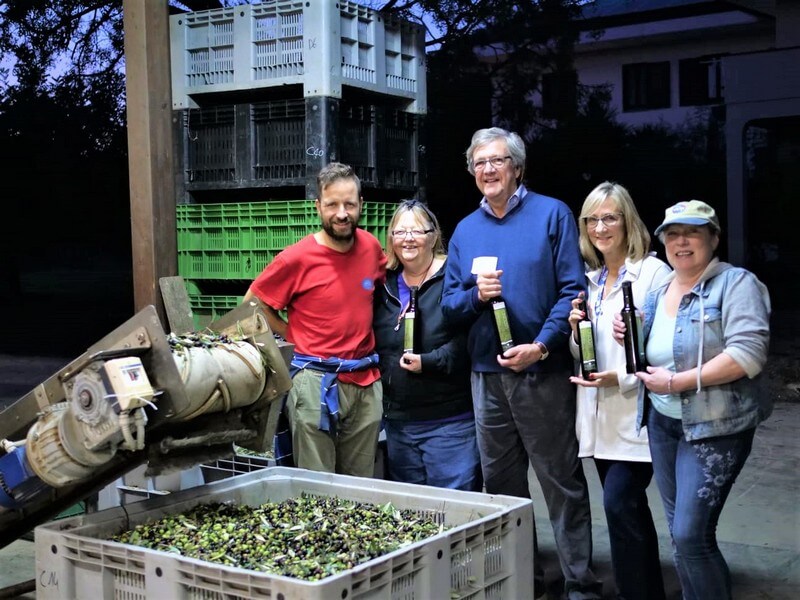
A good EVOO (Extra Virgin Olive Oil) is obtained exclusively from the cold pressing of fresh and healthy olives.
It’s a staple not only for Italian cooking but also for a healthy diet.
The quality of the oil depends on multiple factors: the variety of olives, harvesting techniques, and the production process.
In addition to classic extra virgin oil, there are other types of olive oils available on the market, such as virgin olive oil and “refined” olive oil, which do not offer the same nutritional and sensory quality.

Differences Between Types of Olive Oil
Not all of extra virgin olive oil are equal.
One of the quality indicators is acidity, a measure rarely listed on labels and usually only available in specialized brochures.
The acidity level of an extra virgin olive oil should be below 0.8%, indicating that the olives were fresh and that the extraction process was properly managed.
Oils with higher acidity are not considered extra virgin. They might be classified as virgin olive oil or simply olive oil (without the ‘virgin’ label, indicating a lower grade), but they won’t meet the standards for extra virgin olive oil.
An Invitation to Discover True Extra Virgin Olive Oil in Abruzzo
If you have the opportunity, I invite you to experience firsthand the olive harvesting and oil production process in Abruzzo.
You’ll see how quality oil is made and will be able to buy it directly from the producer, ensuring a genuine product.
Immerse yourself in the sights, sounds, and flavors of the olive harvest. Join our unique tour in late October to witness this age-old tradition and taste the exquisite oil made from freshly picked olives.
I recommend exploring the full program here: Cultural, Culinary & Olive Harvest Experience in Abruzzo.
Choosing an Italian extra virgin olive oil, preferably:-) from Abruzzo, means ensuring an authentic product with excellent sensory and nutritional qualities.
Everything else is pale imitation!
You don’t need to be a sommelier to understand the quality of a good Extra Virgin Olive Oil!
Here some easy tips for choosing the best EVOO:
Practical Tips for Choosing a Quality Bottle:
Look for Dark Bottles, Not Clear Ones
Extra virgin olive oil is sensitive to light, which can degrade its quality over time. A dark glass bottle protects the oil from sunlight and helps preserve its freshness, flavor, and nutritional value.
Remember, the color of the oil is not a reliable indicator of quality. Focus on dark glass bottles and other indicators of quality to ensure you’re getting the real deal.
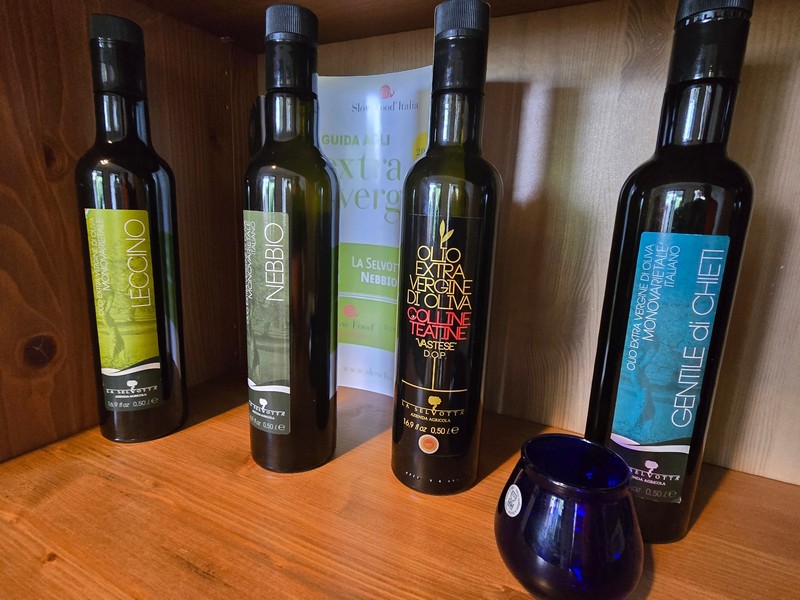
Examine the Label Carefully
The label provides essential information that can guide you in selecting a high-quality olive oil. Here’s what to look for:
- Product Designation: The label should clearly state “Olio Extra Vergine di Oliva” (or “Extra Virgin Olive Oil” in English). This designation indicates that the oil is made from the cold pressing of olives without the use of chemicals or refining processes, ensuring a pure product.
- Origin of the Olives: Quality oils specify the origin of the olives, ideally indicating that they are 100% from Italy or another specific region. Look for “DOP” (Denominazione di Origine Protetta) or “IGP” (Indicazione Geografica Protetta) certifications if possible; these ensure that the oil comes from a specific geographical area and follows strict production standards. Be cautious with terms like “Made in Italy” or “Bottled in Italy,” which may only refer to where the oil was packaged, not the origin of the olives themselves. Imported olives may have aged during transport, which can affect freshness and quality.
- Producer Information: The label should include the name, address, or company name of the producer or bottler, providing transparency about where the oil was produced and by whom.
- Harvest Year (Optional but Recommended): Some bottles also indicate the harvest year, a sign of freshness. Extra virgin olive oil is best consumed within 18-24 months from the harvest for optimal flavor and nutritional value.
- Extraction Method: Look for terms like “cold-pressed” or “cold-extracted,” which ensure that the oil was produced at low temperatures (below 27°C). This preserves more of the oil’s nutrients and sensory qualities.
- Nutritional Information: By law, the label should include nutritional details, with information on fats, saturated fats, carbohydrates, sugars, protein, and salt.
- Expiration Date or “Best Before” Date: The label should also include a date indicating freshness. This “Best Before” date helps you gauge how long the oil will retain its best qualities.
- Batch Number: Each bottle should include a lot number, which ensures product traceability in case there is ever a need to track a specific batch.
By carefully reading the label, you can better understand the quality of the oil you are buying and ensure that you’re selecting a product that will enhance your cooking and offer nutritional benefits.

Practical tips if you have the opportunity to taste it before making the actual purchase:
Test Fluidity by Swirling the Oil
Swirl a bit of oil in a glass to check its consistency.
High-quality extra virgin olive oil should neither be too thin nor too thick.
Excessive fluidity may indicate a mix with lower-grade oils.
Tasting high-quality extra virgin olive oil is a sensory experience, much like wine tasting. Here’s how to appreciate its nuances:
Engage Your Senses (If You Can Taste It):
- Warm it up: Pour a small amount into a glass and cup it in your hands for about a minute to release aromas and flavors.
- Swirl and sniff: Gently swirl the oil and inhale deeply. What aromas do you detect? Freshly cut grass? Almonds? Artichokes?
- Taste it like a sommelier (“strippagio”): Take a small sip and draw air in through your teeth, making a subtle slurping sound. This aerates the oil and intensifies the flavors.
- Savor the flavors: Is it fruity, bitter, pungent (peppery), or sweet? A high-quality extra virgin olive oil should have a harmonious balance.
- Try it on bread (optional): This can help you appreciate its texture and how it complements other flavors.
- Cleanse your palate: Just like with wine tasting, cleanse your palate with water or a slice of apple between tasting different oils.

Key Taste Characteristics:
- Bitter: Indicates unripe olives and a high antioxidant level.
- Fruity: Reminiscent of fresh olives, a hallmark of quality.
- Pungent: A peppery bite from young olives, often high in polyphenols.
- Sweetness: While it shouldn’t be overly sweet, a quality oil can have a mild, smooth finish.
By following these tips, you can confidently choose extra virgin olive oil that is not only delicious but also packed with health benefits.
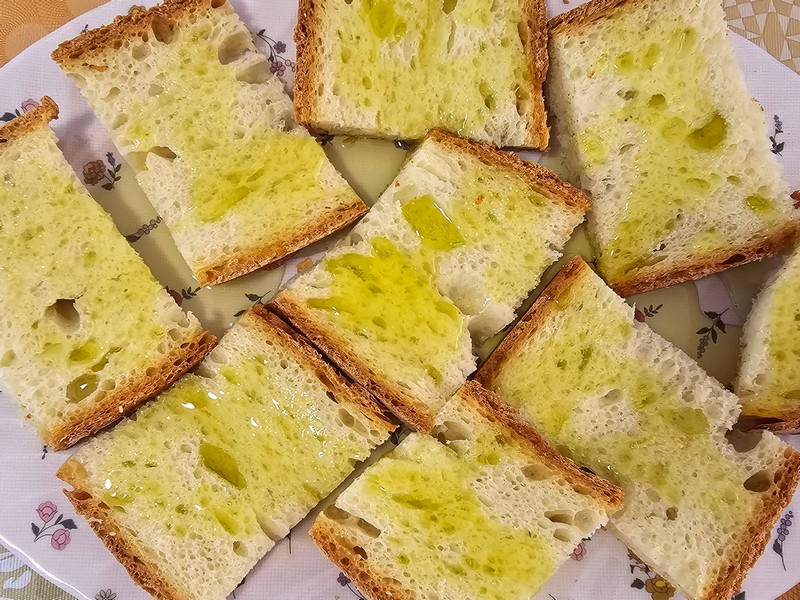
A Note on Color
Don’t be fooled by appearances! While a deep green or golden yellow might seem appealing, the color of olive oil doesn’t always indicate superior quality. The shade actually depends on the olive varieties used and the soil they’re grown in.
To avoid being swayed by color alone, try observing the oil in a colored glass. This will help you focus on other important factors like aroma and flavor.
Unfortunately, some commercial producers might artificially enhance the color of their oil to make it look more attractive, even if the quality isn’t the best. This is often done to boost sales, rather than prioritize the integrity of the oil.
Remember, true quality goes beyond just appearances.

General tips:
Oil Storage
Store the oil in a cool place, away from light and air, ideally in dark bottles.
Oxidation is the main enemy of freshness: even the best oil loses its properties if exposed to light or heat.
Avoid storing it in the refrigerator.
Culinary Uses
For enhancing dishes, extra virgin olive oil is perfect when used raw: drizzle it over salads, grilled vegetables, bruschetta, or fish for a full and rounded flavor.
It’s also ideal for adding richness to simple dishes like soups or legumes.
In Abruzzo, we cherish our extra virgin olive oil. It’s not just for drizzling over salads or dipping bread; we use it in all our cooking, even baking!
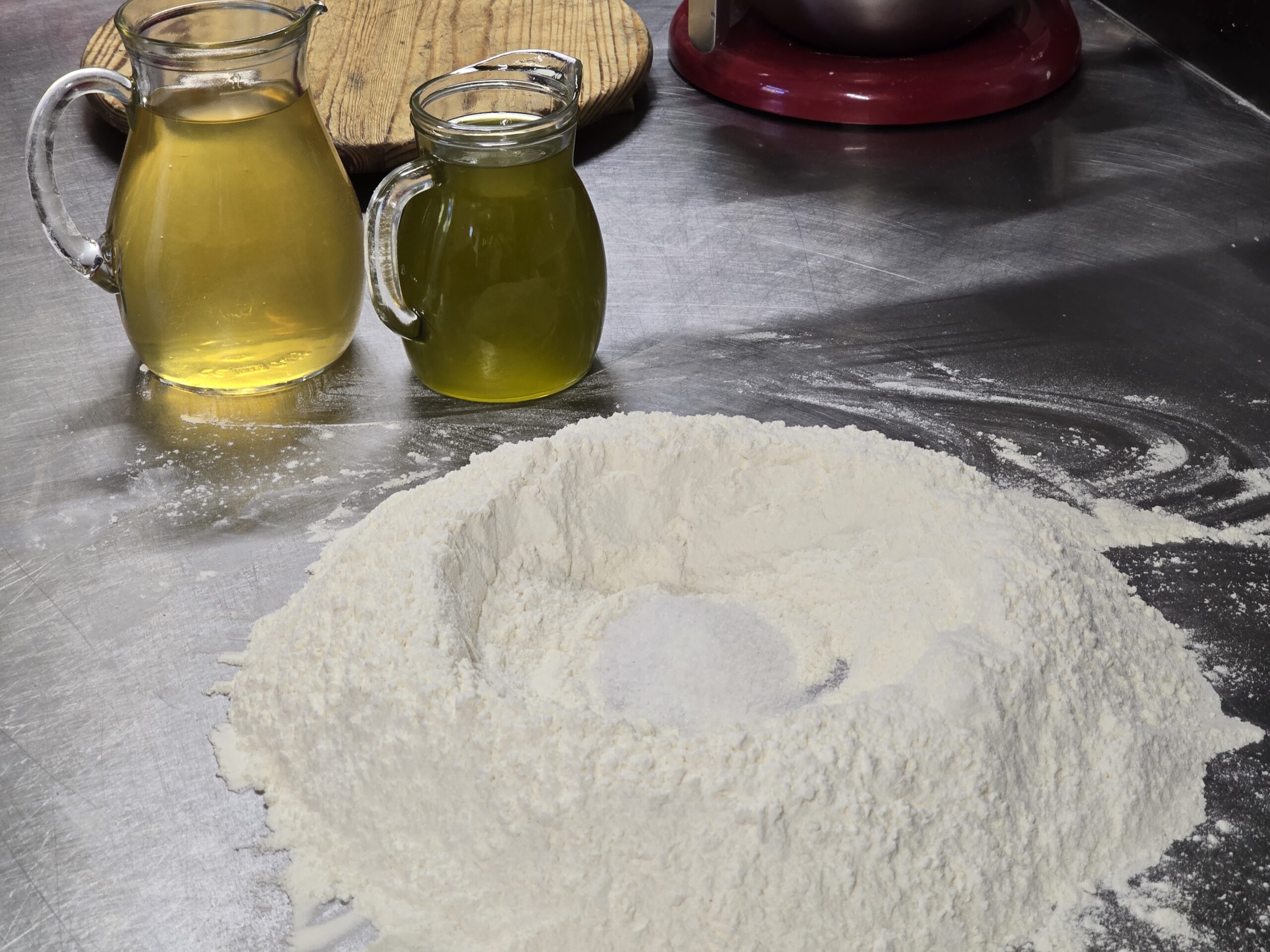
One of my favorite examples is “tarallucci olio e vino” – traditional extra virgin olive oil and wine biscuits. They’re especially popular in the lower parts of our region. These delightful treats showcase the rich flavor and aroma of our local extra virgin olive oil, combined with simple ingredients like flour, wine and a touch of sweetness from our homemade jams.
If you’re curious to learn more about these regional specialties and how to make them, join us on one of our Abruzzo tours! You’ll have the chance to connect with local traditions and learn from the masters (like my mother Anna Maria and my cousin Rosa!) who have been baking these delicious biscuits for generations.
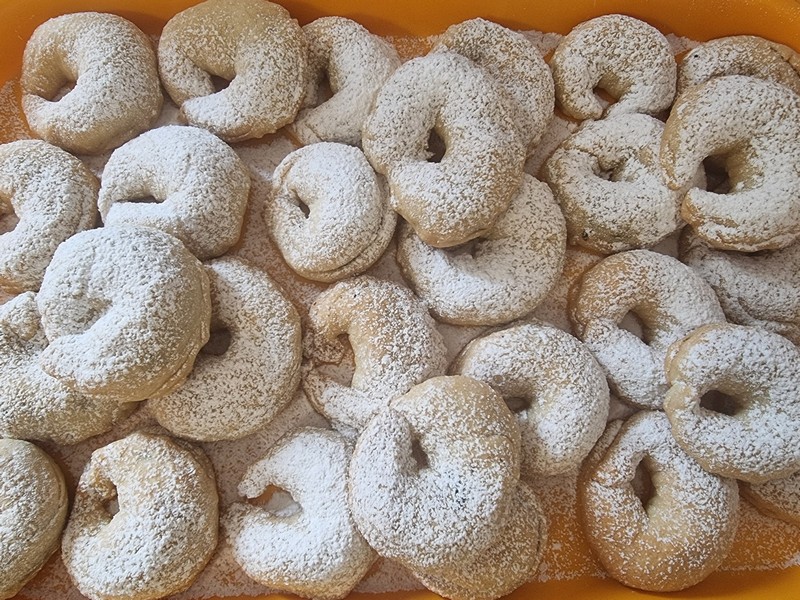
Sustainability and Local Choices
Supporting local producers, such as those in Abruzzo, promotes sustainable agriculture practices and guarantees fresh products.
The proximity between olive groves and mills helps reduce environmental impact while enhancing quality.
Polyphenols: The Tiny Powerhouses in Olive Oil
Last but not least: invest a little more for your health.
Don’t shy away from those bitter and spicy notes in your olive oil! They’re a sign of high polyphenol content, and that’s a good thing. Polyphenols are natural antioxidants that pack a powerful punch when it comes to your health.
Think of them as tiny warriors fighting off free radicals in your body, protecting your cells from damage, and promoting heart health. They’re also linked to various other benefits, including:
- Reduced inflammation: Polyphenols help combat inflammation, which is a key factor in many chronic diseases.
- Improved brain function: Studies suggest that polyphenols can enhance memory and cognitive function.
- Cancer prevention: Some research indicates that polyphenols may play a role in preventing certain types of cancer.
How to Get More Polyphenols:
- Choose early harvest oils: Oils made from olives harvested early in the season tend to have higher polyphenol content. They usually have a more robust, peppery flavor.
- Look for quality indicators: As we’ve discussed, factors like low acidity, dark glass bottles, and proper storage all contribute to preserving polyphenols.
- Don’t be afraid of the “bite”: That slightly bitter or pungent taste is a sign of those healthy polyphenols at work!
Investing in Your Health:
While high-polyphenol olive oil might cost a bit more, consider it an investment in your well-being. By choosing quality oil, you’re not just getting a delicious flavor; you’re also getting a concentrated dose of health-promoting compounds.
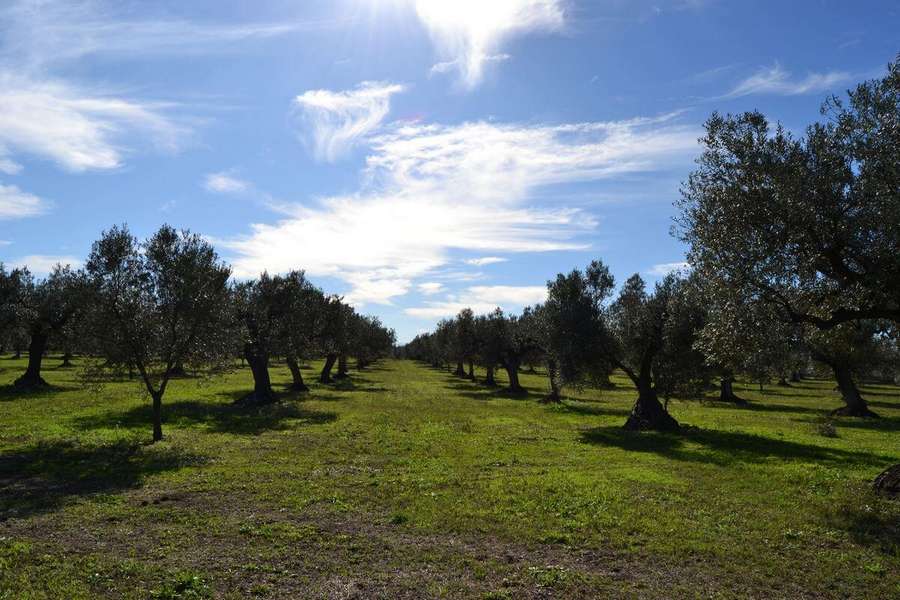
Olive Oil Experience in Abruzzo
If you’re passionate about olive oil, our Abruzzo tours offer a unique opportunity to delve deeper into its world. Throughout the year, you can savor local oils, learn about their production, and even use them in traditional recipes.
And for a truly immersive experience, join our special olive harvest tour in late October! You’ll get to participate in the harvest firsthand, visit a local olive mill, explore the olive groves, and witness the entire production process. Of course, tasting the exquisite, freshly-pressed oil is a must!
It’s a unique opportunity to understand the dedication that makes Abruzzo olive oil so special.
The region generally enjoys warm, ideal weather for the harvest, and visitors can often participate dressed in light clothing.

Ready to immerse yourself in the world of olive oil and experience the authentic heart of Italy?
Explore our tour calendar and discover a range of experiences that will tantalize your taste buds and deepen your appreciation for this liquid gold. From savoring local oils to learning about their production and even participating in the harvest, our tours offer something for every olive oil enthusiast.
Don’t wait another moment to start planning your Italian adventure! Contact me today, and let’s bring your travel dreams to life.

And if you’re not quite ready to make an inquiry, sign up for our free email course to learn everything you need to know about planning a tour of Abruzzo.
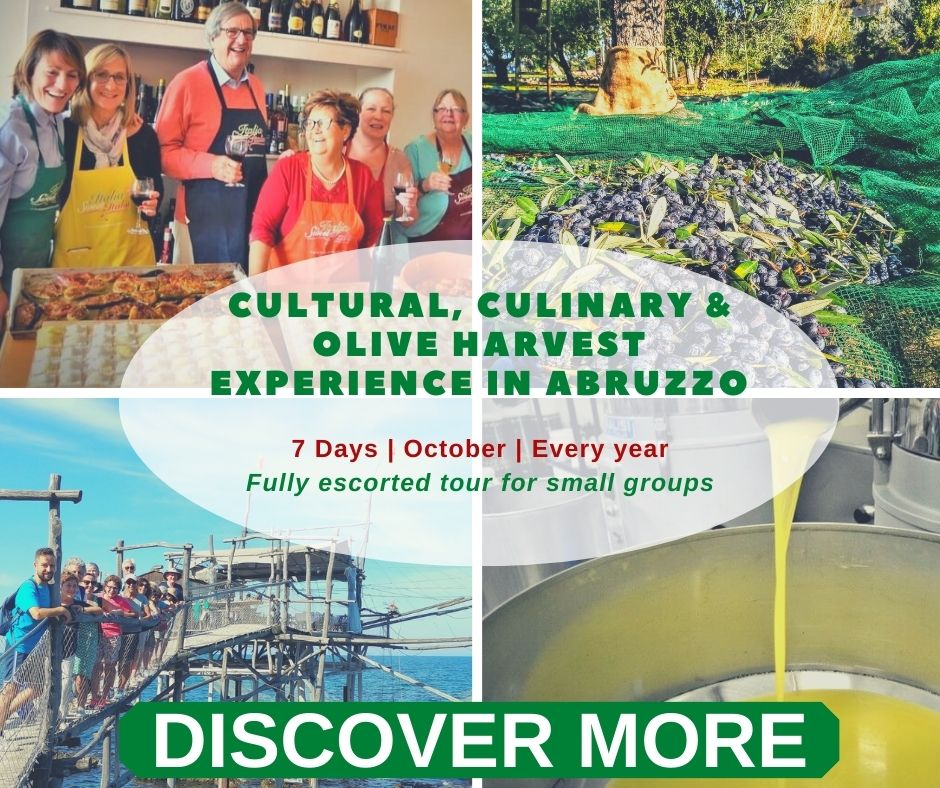

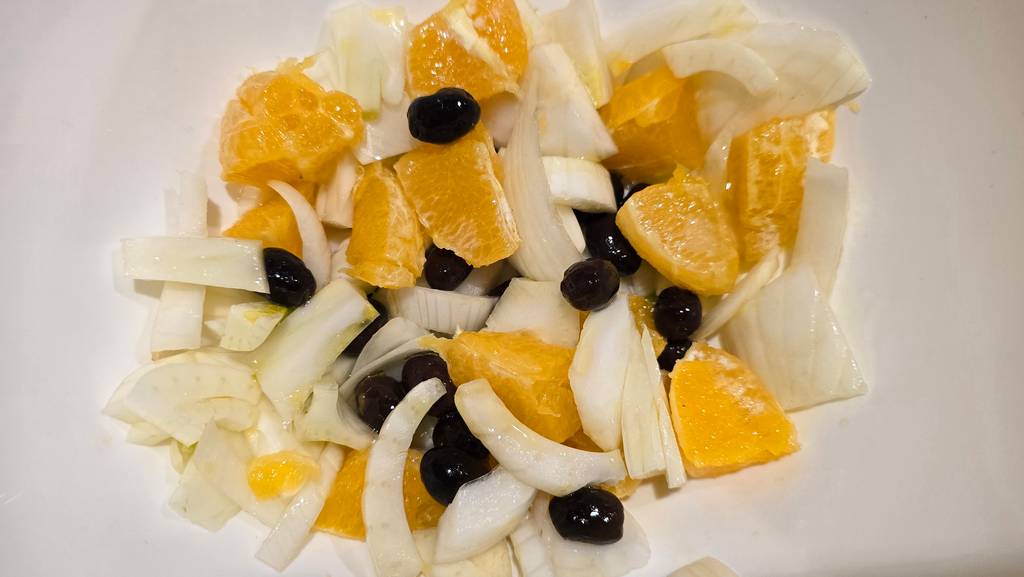

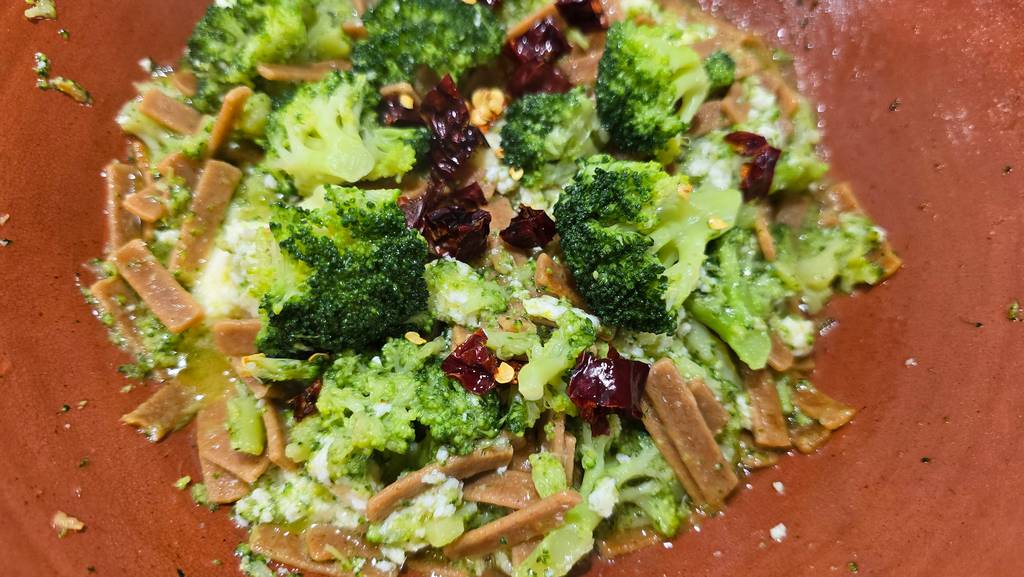

6 thoughts on “The Ultimate Guide to Extra Virgin Olive Oil: Taste, Health, and Quality”
Thanks for this. Will try it out when I get home. Have a feeling it will fail!
The important is being relaxed and have fun!
Ops! I forgot, don’t smoke or eat before your tasting session! 🙂
Very educative
Ciao Joseph,
Thanks for your feedback.
I’m glad you found it informative.
Keep following us for more!
Ciao for now
Fabrizio
Do you know the Olivastro brand of olive oil?
This is my mother’s maiden name! Her mother’s maiden name was Sciorilli.
The come from Province de Chieti, San Eusanio Sangro.
Do you know it?
Buongiorno Grace,
How wonderful to hear about your family roots; what a beautiful connection to Abruzzo!
We’re not familiar with the Olivastro olive oil brand, though it certainly sounds intriguing, especially given your family history.
Sant’Eusanio del Sangro is actually quite close to us, just about an hour from Vasto, where our base is located.
If you’re interested in discovering our tours, you can take a look here: http://www.italiasweetitalia.com
Ciao for now
Fabrizio